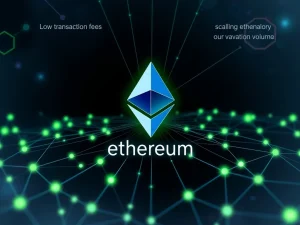Ambitious Ethereum Scaling: Researcher Proposes 100x Gas Limit Increase Over 4 Years

Big news for anyone following the pulse of the crypto world, especially Ethereum enthusiasts! A significant proposal is on the table that could dramatically reshape Ethereum’s capabilities. An Ethereum Foundation researcher has put forward an ambitious plan to increase the blockchain’s gas limit by a factor of 100 over the next four years. This move aims to tackle one of the network’s key challenges: scaling.
Understanding the Proposed Ethereum Gas Limit Increase
The proposal, known as EIP-9698, comes from Ethereum Foundation researcher Dankrad Feist. If implemented, it would introduce a scheduled, deterministic growth for the Ethereum gas limit. The plan suggests a gradual increase starting around June 1st (epoch 369017). The limit would increase by 10x over approximately two years, followed by a final 10x increase, reaching a total 100-fold increase over four years.
Currently, the Ethereum gas limit is around 36 million. A 100x increase would push this to 3.6 billion. This change would require Ethereum clients to vote on the proposal for it to become active. Feist stated that this predictable growth pattern is designed to align with expected advancements in hardware and protocol efficiency, encouraging a sustainable trajectory for the network.
Potential Impact: Boosting Ethereum TPS
One of the most exciting potential outcomes of a 100x gas limit increase is a significant boost in Ethereum’s transaction processing speed (TPS). Ethereum’s TPS can currently reach around 20 for simple transactions in certain blocks. Theoretically, a 100-fold increase in the gas limit could raise Ethereum’s potential TPS to 2,000.
This potential increase in TPS would position Ethereum more competitively against other fast blockchains like Solana, which processes a non-vote TPS between 800 and 1,050 and has a theoretical maximum much higher. A higher gas limit also means that potentially around 6,000 transactions could fit into a single Ethereum block, compared to the current capacity.
Addressing Challenges in Scaling Ethereum
Increasing the gas limit isn’t without potential challenges. Feist acknowledged that a rapid increase could stress less-optimized nodes on the network and potentially increase the time it takes for new blocks to propagate across the network. However, the proposed exponential schedule involves very gradual increments per epoch. This approach aims to give node operators and developers ample time to adapt their systems and optimize performance to handle the higher load.
This proposal marks a notable effort to boost scalability directly at the Ethereum base layer. In recent years, the focus for scaling Ethereum has largely been on Layer 2 solutions. While Layer 2s have provided significant scaling benefits, critics sometimes point out that this approach can lead to ecosystem fragmentation and potentially impact interoperability and user experience across different Layer 2 chains.
EIP-9698 and the Future of Ethereum Scaling
EIP-9698 represents a potential shift or addition to the Ethereum scaling roadmap, bringing attention back to base layer capacity. It’s also worth noting that this isn’t the only gas limit related EIP being discussed. Ethereum developers are also exploring testing a fourfold increase of the gas limit under EIP-9678 as part of the potential Fusaka hard fork, which might go online in late 2025. The next major network upgrade, Pectra, is currently scheduled for May.
The proposal for a 100x increase in the Ethereum gas limit is ambitious and signals a long-term vision for the network’s growth. If approved and successfully implemented, it could significantly enhance Ethereum’s capacity and competitiveness in the blockchain landscape, potentially handling a much higher volume of transactions directly on the mainnet.
Summary
Ethereum Foundation researcher Dankrad Feist has proposed EIP-9698, an ambitious plan to increase the Ethereum gas limit by 100 times over four years. This scheduled increase, starting around June 1st, aims to boost the network’s theoretical TPS to 2,000 and allow more transactions per block. While challenges like node stress are acknowledged, the gradual implementation is designed to allow adaptation. This proposal highlights a renewed focus on base layer scaling alongside ongoing Layer 2 development, potentially shaping the future capacity of the Ethereum network.









